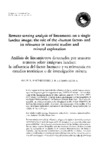Remote sensing analysis of lineaments on a single landsat image: the role of the "human factor" and its relevance in tectonic studies and mineral exploration

View/
Use this link to cite
http://hdl.handle.net/2183/6066Collections
Metadata
Show full item recordTitle
Remote sensing analysis of lineaments on a single landsat image: the role of the "human factor" and its relevance in tectonic studies and mineral explorationAlternative Title(s)
Análisis de lineamientos detectados por sensores remotos sobre imágenes landsat: la influencia del factor humano y su relevancia en estudios tectónicos o de investigación mineraDate
1990Citation
Cadernos do Laboratorio Xeolóxico de Laxe, 1990, 15: 157-170 ISSN: 0213-4497
Abstract
[Abstract] In the present work we deal with the influence of the so-called «human component
» on lineament photointerpretation and LANDSAT images. The statistical study of the lineaments drawn by three different analysts on the same LANDSTAT image is performed, being the tested a geologically well-known portion of the Iberian Hercynian Mássif: the Badajoz-C6rdoba Shear Zone. The results obtained let us consider attentively the role played by the analyst subjectivity on the finallineament networks. As a result, the consequence of the studies of this type on mineral exploration and tectonics are discussed, being undeniable the
validity of this technique. [Resumen] En este trabajo se estudia la influe'ncia del que se ha dado en denominar «componente humano» en la fotointerpretación de lineamentos estructurales sobre imágenes LANDSAT. Se realiza un estudio estadístico de las fotolíneas dibujadas sobre un mismo soporte fotográfico por tres analistas diferentes. El área uálizada para la realización de la prueba es el Corredor Blastomilonítico de Badajoz Córdoba, una región relativamente bien conocida del Macizo Ibérico. Los resultados y conclusiones alcanzados permiten efectuar una estimación semicuantitativa del papel jugado por la subjetividad del analista sobre las redes de fotolíneas obtenidas. Las principales consecuencias que se derivan de este estudio son discutidas desde la perspectiva de la tectónica y de la exploración mineral, resaltando la validez de la técnica de teledetección utilizada.
Keywords
Remote sensing
Lineaments
Subjectivity
Tectonics
Mineral exploration
Badajoz-Córdoba Shear Zone
Teledetección
Lineamientos
Subjetividad
Tectónica
Exploración mineral
Corredor Blastomilonítico de Badajoz-Córdoba
Lineaments
Subjectivity
Tectonics
Mineral exploration
Badajoz-Córdoba Shear Zone
Teledetección
Lineamientos
Subjetividad
Tectónica
Exploración mineral
Corredor Blastomilonítico de Badajoz-Córdoba
ISSN
0213-4497





